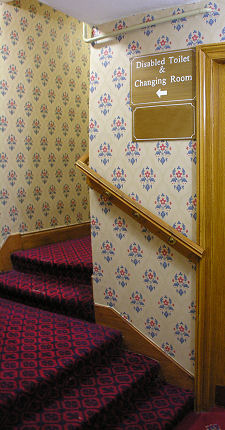 An Example of Excellent Visitor Accessibility: The Royal Yacht Britannia |
Disabled access in Scotland is a mixed picture. On the one hand more and more businesses, transport providers and visitor attractions are making ever greater efforts to improve access to their premises, vehicles and attractions. On the other, Scotland is an old, even an ancient, country, and very many of its buildings were constructed in an era when equality of any form was a fairly alien idea.
Through most of Scotland's history the prevailing view of "accessibility" was typified by the direction of rotation of the spiral stairs found in so many of our castles: designed specifically to allow a typically right-handed resident higher up the stairs to gain an advantage in a sword fight with an interloper trying to climb them. However you look at it, a great deal of Scotland's "built environment" was simply not designed with easy access in mind.
Disabled access in Scotland has steadily been taken more seriously, from a low base, for the last couple of decades. A major impetus was given with the legal obligations applied in the Disability Discrimination Act 1995, supplemented by those in the Disability Discrimination Act 2005. These Acts, which apply right across the UK including Scotland, now give disabled people rights in the areas of employment; education; access to goods, facilities and services; and buying or renting land or property.
From a visitor's point of view, the most important of these are the rights under the DDA of "access to goods, facilities and services". As a result of the legislation, businesses and others who had not previously taken disabled access seriously have had to do so. Yet, despite this, the picture remains patchy.
There are several reasons for this. One is unavoidable: some premises or attractions are simply not possible to make accessible. Perhaps the most striking example of this is Dumbarton Castle. This is, in effect, a volcanic plug over which have been placed a scatter of buildings, linked together by 547 steps. It is not possible even to enter the main gate without climbing 14 stone steps first. Because of the nature of Scotland's landscape and many of its buildings, there are obvious and justifiable limits to the lengths that access can be stretched.
Though having said that, there are in Scotland also examples of excellent access being provided through good design and lateral thinking to premises or attractions which might initially have been dismissed as impossible to access. The most obvious example of this is the Royal Yacht Britannia, in Leith. Here a ship built in an era when accessibility was not a consideration has been made fully accessible to visitors - without changing its essential character - by allowing multi-level access from a tower in which the levels are linked together by lift.
The picture in Scotland also remains patchy because of fairly widespread ignorance and, in particular, a failure to appreciate that "disability" takes many different forms. While, therefore, some progress is being made in ensuring wheelchair access to shopping facilities across the country, visitors to Edinburgh with an upper body disability will find many shop (and other) doors are simply too heavy to open.
And the picture in Scotland sometimes remains patchy simply because of thoughtlessness. One university in central Scotland has a library with a button-operated door to allow disabled access. But when it is windy, as it often is in the city in which this university is found, the door is locked shut and no alternative arrangements are put in place. And, too often, the sort of thing shown in the picture on this page can still be found. This upmarket hotel in central Scotland seems to believe that having a disabled toilet is all it needs to do, however (in)accessible that toilet might be in practice!
On Undiscovered Scotland we are seeking to provide disabled visitors with the best possible service in a number of ways. Firstly by ensuring that the web site itself is accessible to as wide a range of visitors as possible. Secondly, our links page Disability Information & Support, gives access to a number of key online resources for disabled visitors to and residents in Scotland. Thirdly, our listings of accommodation providers across Scotland highlight accessibility information wherever possible. And finally, our feature pages about visitor attractions across Scotland include links to accessibility information wherever possible.

